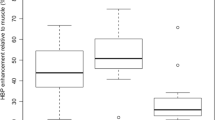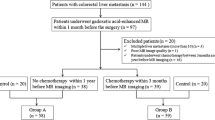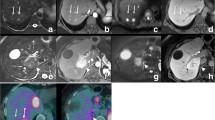Abstract
Purpose
To describe the MRI findings in colorectal cancer liver metastases using gadoxetic acid (Gd-EOB-DTPA), with special emphasis on the target feature seen on the hepatobiliary phase.
Material and methods
The medical records of 45 colorectal cancer patients with an overall number of 150 liver metastases were reviewed. All patients underwent Gd-EOB-DTPA-enhanced MRI before any kind of treatment. We retrospectively evaluated, for each lesion, the signal intensity on the T1-weighted, T2-weighted, and diffusion-weighted images. Additionally, the enhancement pattern during the arterial-, portal-, equilibrium-, and hepatobiliary-phase was assessed. Fourteen lesions had a pathological correlation.
Results
Lesions size was 5–40 mm (mean 15 mm). All metastases were hypointense on T1-w imaging. Ninety-nine lesions (66%) had a central area of very high signal intensity on T2-w imaging. Fifty-one metastases (34%) were hyperintense on the T2-w images. In DWI, all lesions had a restricted diffusion. The mean ADC value was 1.31 × 10−3 mm2/s (range 1.10–1.45 × 10−3 mm2/s). During the arterial-phase imaging, 61 lesions (41%) showed a rim enhancement, while 89 lesions (59%) appeared as hypointense. All lesions had low signal intensity in the portal and equilibrium phase. Thirty-nine percent of the lesions also showed an enhancing rim on the portal-phase images. During the hepatobiliary phase, 80 lesions (53.3%) were hypointense, while 70 lesions (46.7%) had a target appearance.
Conclusion
A number of metastases show an atypical contrast medium uptake during the hepatobiliary phase of gadoxetic acid-enhanced MRI, consisting in a target appearance.





Similar content being viewed by others
References
Ding Y, Rao S-X, Meng T, et al. (2014) Preoperative evaluation of colorectal liver metastases: comparison of gadopentetate dimeglumine and gadoxetic-acid-enhanced 1.5-T MRI. Clin Imaging 38:273–278
Simmonds PC, Primrose JN, Colquitt JL, et al. (2006) Surgical resection of hepatic metastases from colorectal cancer: a systematic review of published studies. Br J Cancer 94:982–999
Zech CJ, Bartolozzi C, Bioulac-Sage P, et al. (2013) Consensus report of the Fifth International Forum for Liver MRI. AJR 201:97–107
Guenette JP, Dupuy DE (2010) Radiofrequency ablation of colorectal hepatic metastases. J Surg Oncol 102:978–987
Do RK, Rusinek H, Taouli B (2009) Dynamic contrast-enhanced MR imaging of the liver: current status and future directions. Magn Reson Imaging Clin N Am 17:339–349
Low RN (2007) Abdominal MRI advances in the detection of liver tumours and characterisation. Lancet Oncol 8:525–535
Larissa Braga DA, Azzazi ME, Semelka RC (2010) Abdominal-pelvic MRI, 3rd edn. Hoboken: Wiley-Blackwell
Milot L, Guindi M, Gallinger S, et al. (2010) MR imaging correlates of intratumoral tissue types within colorectal liver metastases: a high-spatial-resolution fresh ex vivo radiologic-pathologic correlation study. Radiology 254:747–754
Macera A, Lario C, Petracchini M, et al. (2013) Staging of colorectal liver metastases after preoperative chemotherapy. Diffusion-weighted imaging in combination with Gd-EOB-DTPA MRI sequences increases sensitivity and diagnostic accuracy. Eur Radiol 23:739–747
Koh DM, Collins DJ, Wallace T, Chau I, Riddell AM (2012) Combining diffusion-weighted MRI with Gd-EOB-DTPA-enhanced MRI improves the detection of colorectal liver metastases. Br J Radiol 85:980–989
Donati OF, Fischer MA, Chuck N, et al. (2013) Accuracy and confidence of Gd-EOB-DTPA enhanced MRI and diffusion-weighted imaging alone and in combination for the diagnosis of liver metastases. Eur J Radiol 82:822–828
Terayama N, Matsui O, Ueda K, et al. (2002) Peritumoral rim enhancement of liver metastasis: hemodynamics observed on single-level dynamic CT during hepatic arteriography and histopathologic correlation. J Comput Assist Tomogr 26:975–980
Nino-Murcia M, Olcott EW, Jeffrey RB Jr, et al. (2000) Focal liver lesions: pattern-based classification scheme for enhancement at arterial phase CT. Radiology 215:746–751
Braga L, Semelka RC, Pietrobon R, et al. (2004) Does hypervascularity of liver metastases as detected on MRI predict disease progression in breast cancer patients? AJR 182:1207–1213
Danet IM, Semelka RC, Leonardou P, et al. (2003) Spectrum of MRI appearances of untreated metastases of the liver. AJR 181:809–817
Ha S, Lee CH, Kim BH, et al. (2012) Paradoxical uptake of Gd-EOB-DTPA on the hepatobiliary phase in the evaluation of hepatic metastasis from breast cancer: is the “target sign” a common finding? Magn Reson Imaging 30:1083–1090
Kim A, Lee CH, Kim BH, et al. (2012) Gadoxetic acid-enhanced 3.0T MRI for the evaluation of hepatic metastasis from colorectal cancer: metastasis is not always seen as a “defect” on the hepatobiliary phase. Eur J Radiol 81:3998–4004
Choi JY, Choi JS, Kim MJ, et al. (2010) Detection of hepatic hypovascular metastases: 3D gradient echo MRI using a hepatobiliary contrast agent. J Magn Reson Imaging 31:571–578
Ringe KI, Husarik DB, Sirlin CB, Merkle EM (2010) Gadoxetate disodium enhanced MRI of the liver: part 1, protocol optimization and lesion appearance in the noncirrhotic liver. AJR 195:13–28
Kim YK, Lee JM, Kim CS (2004) Gadobenate dimeglumine-enhanced liver MR imaging: value of dynamic and delayed imaging for the characterization and detection of focal liver lesions. Eur Radiol 14:5–13
Balci NC, Semelka RC (2005) Contrast agents for MR imaging of the liver. Radiol Clin North Am 43:887–898
Reimer P, Schneider G, Schima W (2004) Hepatobiliary contrast agents for contrast-enhanced MRI of the liver: properties, clinical development and applications. Eur Radiol 14:559–578
Van Beers BE, Pastor CM, Hussain HK (2012) Primovist, eovist: what to expect? J Hepatol 57:421–429
Gabata T, Matsui O, Kadoya M, et al. (1998) Delayed MR imaging of the liver: correlation of delayed enhancement of hepatic tumors and pathologic appearance. Abdom Imaging 23:309–313
Acknowledgements
The authors are grateful to Alessandra Trocino, librarian at the National Cancer Institute of Naples, Italy.
Author information
Authors and Affiliations
Corresponding author
Ethics declarations
Conflict of interest
The authors have no conflict of interest to be disclosed.
Human and animal rights and informed consent
All procedures performed in studies involving human participants were in accordance with the ethical standards of the institutional and/or national research committee and with the 1964 Helsinki declaration and its later amendments or comparable ethical standards. Informed consent was obtained from all individual participants included in the study.
Rights and permissions
About this article
Cite this article
Granata, V., Catalano, O., Fusco, R. et al. The target sign in colorectal liver metastases: an atypical Gd-EOB-DTPA “uptake” on the hepatobiliary phase of MR imaging. Abdom Imaging 40, 2364–2371 (2015). https://doi.org/10.1007/s00261-015-0488-7
Published:
Issue Date:
DOI: https://doi.org/10.1007/s00261-015-0488-7




